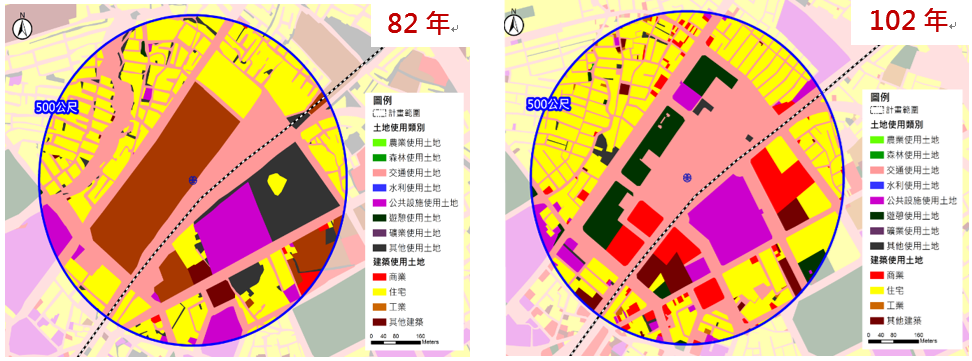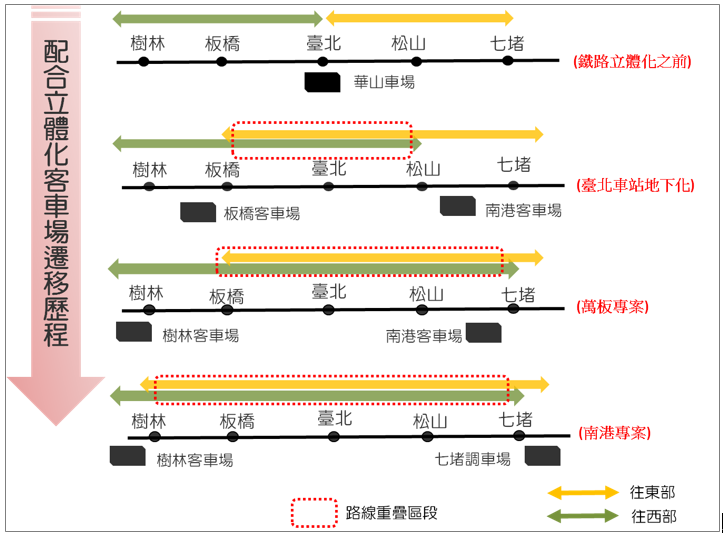Observation and Analysis before and after Railway Grade Separation
- Date:2019-03-06
- Update:2023-09-11
- Department:IOT
Project Overview:
After the railway underground project of the Metropolitan Taipei area in 2002, in addition to eliminate level crossings, the development of the station area and the weaving effects along the railway were also quite obvious. The increase of land price behind Taipei Station was about the same as in front of it. With theHigh Speed Rail route connecting the station at the same time, Taipei Station has become a multimodal transportation transit hub which also drove the development of local economy forward, therefore, all local governments followed suit and competed for Railway Grade Separation projects.
Railway facilities are national public goods with huge construction funds. Based on the government’s financial situation and considerations of effective use and distribution of overall transportation resources, there should be objective and concrete review and evaluation standards for moving the Railway Grade Separation construction forward for all urban areas. To this day, all local governments have successively proposed a number of Railway Grade Separation plans. In order to understand the impact of Railway Grade Separation on traffic improvement and urban development, the existing cases must be performed with in-depth observation and analysis.
Research outcomes:
(1)Taking the Wanhua-Banqiao Project as the object of its case study, the research found that the development around the Taiwan Railways Banqiao Station coincided with the city's readjustment and the moving of aAdministrative agencies and its impact on land use and land value was more significant than that of Wanhua Station, which was not solely affected by the Railway Grade Separation.
(2)The study shows that after the Railway Grade Separation project that eliminated the level crossing, it did reduce Taiwan Railway accidents. However, the operation and maintenance costs of the station route have increased significantly. Take Wanhua Station as an example, operating costs of water and electricity, cleaning, station maintenance and equipment upgrade have increased by 3.9 times, while maintenance costs increased by 8.1 times.
(3)After the Railway Grade Separation, the number of station tracks allowed to be configured in the Taiwan Railways station was greatly reduced, and only barely met passenger transport demand, while other original functions of cargo freight, military or machine storage were forced to be moved somewhere else, greatly reducing the flexibility of train dispatching.
(4)This research collected the prerequisites of Grade Separation listed in the “Grade Separation Outlines for Urban Railway Roads and Railway Continuous Crossings” of the Ministry of Land, Infrastructure, Transport and Tourism of Japan, analyzed the problems facing the existing “Directions Governing Application and Review of Railway Grade Separation Construction and Surrounding Land Development Plan”, and proposes specific recommendations for short, medium and long-term revisions.
Promotion of Outcomes and Benefits:
(1)In the symposium of experts and scholars on the "Urban Rail Transit - Railway Grade Separation and MRT Review Progression Direction" at the Railway Reconstruction Bureau on January 11, 2017, this Institute shared the prerequisites of Railway Grade Separation listed in the "Grade Separation Outlines for Urban Railway Roads and Railway Continuous Crossings", from the Ministry of Land, Infrastructure, Transport and Tourism of Japan, collected by this study, and provided these as references for the revision of the Directions for Railway Grade Separation.
(2)This Institute convened a symposium of experts and scholars for the “Impact Analysis of Railway Grade Separation Construction on Transportation and Urban Development” on September 28, 2017, which provided references for the review by the central government through the recommendations by the domestic railway experts.
(3)This Institute published the “Impact Analysis of Railway Grade Separation Construction on Transportation and Urban Development” in the 2017 Academic Paper Seminar of the Chinese Institute of Transportation in December 2017.
(4)When the Ministry of Land, Infrastructure, Transport and Tourism of Japan and the Japan Transportation Planning Association came to visit this Institute on November 23, 2017, the research outcomes were shared with the Japanese visitors.
(5)During the research period, the relevant units of the Department of Railways and Highways, Taiwan Railway Administration and the Railway Reconstruction Bureau have been invited to participate in all work meetings, and the research outcomes will be internalized to the review operations of related projects.
Summary of Key Resarch Outcomes :
Diversified Land use, Increased Commercial Area









